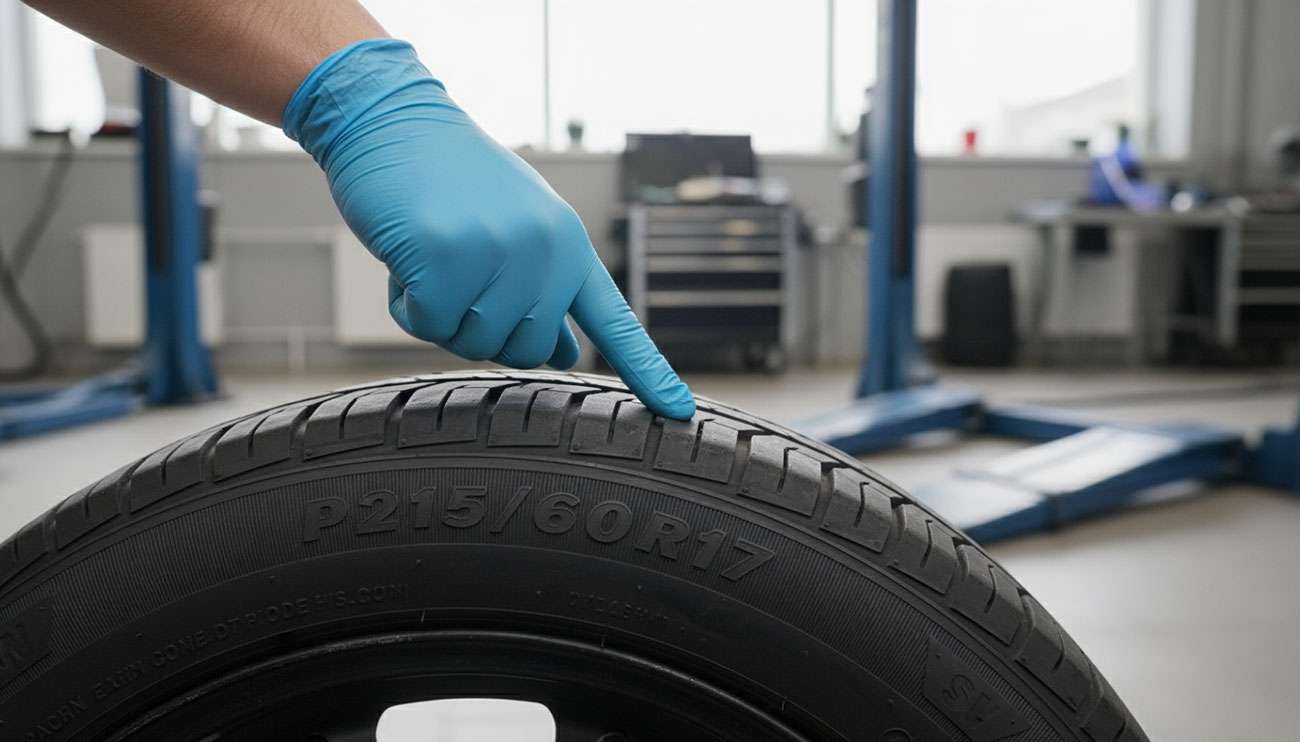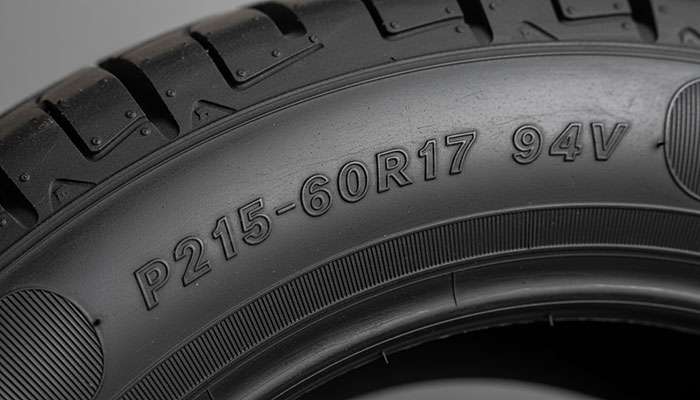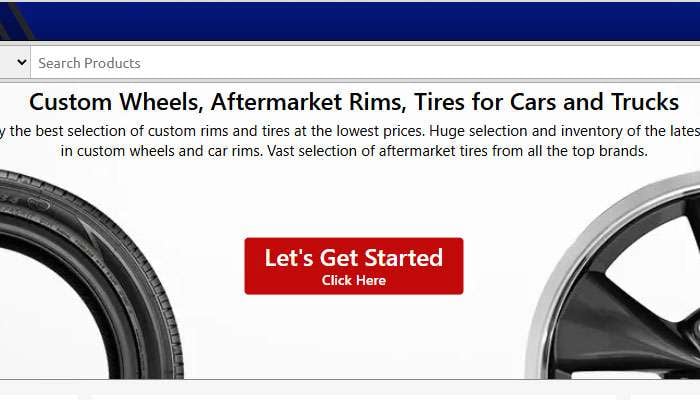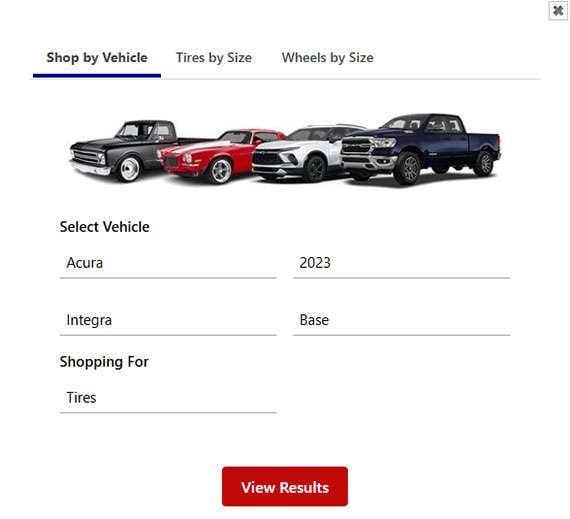
Those numbers and letters stamped on your tire's sidewall aren't just random markings – they're a precise code that tells you exactly what size tire fits your car. When you know how to read them, finding the perfect replacement tires becomes straightforward.
Your tire's sidewall contains three main sections of information that tire manufacturers use to communicate everything about your tire's specifications. The sidewall is simply the outer and inner walls on the sides of a tire, and these surfaces hold the key to proper fitment.
Can't make sense of all those codes? We understand completely. You can also find your correct tire size in your vehicle's owner's manual or on the OEM sticker inside your driver's door. OEM stands for Original Equipment Manufacturer – these are the exact tire specifications that came with your vehicle from the factory.
At Performance Plus Tire, we know that choosing the wrong tire size can affect your vehicle's performance, safety, and even void your warranty. That's why we've created this guide to help you understand exactly how to find your correct tire size, decode those sidewall markings, and select tires that deliver both perfect fit and optimal performance for your specific vehicle.
Our experts will show you the most reliable methods for determining your tire size and explain what all those numbers and letters actually mean. Whether you're replacing worn tires or upgrading for better performance, getting the size right is the foundation of everything else.

When it comes to finding your tire size, you have three reliable sources that provide the exact specifications your vehicle needs. Each location offers the same critical information, so you can choose whichever method works best for your situation.
Your current tires tell the story right on their sidewalls. Look for a sequence of numbers and letters molded into the rubber – something like "P215/60R17". This code contains everything you need to know about your tire's width, aspect ratio, and diameter.
Write down or photograph the complete sequence when you find it. Keep in mind that previous owners might have installed different sizes than what originally came with your car, so it's smart to verify this information with other sources.
The most dependable place to find your recommended tire size is on the tire information placard located in your driver's side door jamb. Open your driver's door and examine the car's frame where the door latches – you'll find a manufacturer-placed sticker with detailed specifications.
This placard includes more than just tire size. You'll also discover:
Load carrying capacity (maximum weight allowed)
Speed rating (maximum speed allowed)
Recommended inflation pressures
If your vehicle lacks a traditional B-pillar, check the rear edge of the driver's door or look for the label on an inward-facing surface near the driver's seat.
Your glove compartment holds another valuable resource for tire size information. The owner's manual contains comprehensive details about your vehicle's recommended tire specifications, matching exactly what appears on your door placard. Use the index to quickly locate the wheels and tires section.
Once you know your tire size, finding the perfect tires for your vehicle on our website is quick and easy. We've designed multiple search methods to help you locate exactly what you need, whether you prefer searching by vehicle or by tire size.
The fastest way to find tires that fit your specific vehicle is through our Vehicle List tool. Simply enter your vehicle's year, make, model, and trim level, and our system will show you all compatible tire options designed for your exact specifications.

This method ensures you see only tires that meet your vehicle's OEM specifications, taking the guesswork out of compatibility. You'll be able to compare different brands, tread patterns, and price points – all guaranteed to fit your vehicle perfectly.
If you're browsing our homepage, simply click the red "Let's Get Started" button to launch our interactive tire finder. This tool walks you through the selection process step by step.

After clicking, you'll see options to shop by vehicle, tires by size, or wheels by size. Select your preference, and the tool will guide you through entering your specific information.

You can search by your original tire size or explore optional sizes if you're considering plus-sizing or different fitments. The system will show you which sizes are compatible with your vehicle and help you understand the differences between options.
Both methods connect you directly to our inventory, showing real-time availability, pricing, and detailed specifications for every tire option. Our customer service team is always available if you need additional guidance during your search.
Understanding these sidewall codes is essential for selecting the right replacement tires. Each marking serves a specific purpose in determining compatibility and performance for your vehicle.
Most tire size markings follow a standard format like "P225/65R17." The "P" designates a passenger vehicle tire. The number "225" represents the tire width measured in millimeters from sidewall to sidewall.
The number following the slash (65) is the aspect ratio – this shows the sidewall height as a percentage of the tire's width. A tire with a 65 aspect ratio means the sidewall height equals 65% of the tire's width.
The "R" indicates radial construction, which is standard for modern tires. The final number (17) represents the wheel diameter in inches. These measurements work together to determine the tire's overall diameter and ensure proper fitment.
The markings after the size (like "91S") provide crucial safety information. The number is the load index, indicating the maximum weight each tire can safely support when properly inflated. Load index 91 equals 1,356 pounds per tire.
The letter shows the speed rating – the maximum sustained speed capability:
S: 112 mph
H: 130 mph
V: 149 mph
W: 168 mph
Y: 186 mph
Never install tires with lower load or speed ratings than your vehicle's original specifications.
The DOT (Department of Transportation) code confirms the tire meets federal safety standards. The last four digits tell you when the tire was manufactured – the first two numbers show the week, the last two show the year.
UTQG (Uniform Tire Quality Grading) ratings help you compare tire performance:
Treadwear: Comparative wear rate rating
Traction: Wet stopping ability graded AA, A, B, or C
Temperature: Heat resistance graded A, B, or C
Special symbols indicate specific performance capabilities. M+S (Mud and Snow) marking shows basic all-season capability. The Three-Peak Mountain Snowflake symbol means the tire meets specific snow traction performance requirements and qualifies as a true winter tire.
Some tires display manufacturer-specific symbols indicating original equipment approval for particular vehicle makes. BMW uses a star symbol, Mercedes-Benz uses "MO," and Porsche uses "N" specifications.

Original Equipment tires aren't just recommendations – they represent years of engineering collaboration between vehicle manufacturers and tire companies. Understanding their importance helps you make better replacement decisions.
Vehicle manufacturers work directly with tire companies to develop tires specifically engineered for each vehicle model. These tires undergo extensive testing to match the vehicle's weight distribution, suspension tuning, and performance characteristics.
OE tires often feature special compounds and construction details not found in their retail counterparts. A tire marked with a vehicle manufacturer's symbol (like BMW's star or Mercedes' MO designation) has passed that automaker's rigorous performance standards.
Luxury and performance vehicles require OE-approved tires more strictly than economy cars. High-performance vehicles depend on specific tire characteristics for optimal handling, braking, and stability control system operation.
Your vehicle warranty may require OE-approved tires. Some manufacturers specify that using non-OE tires could void certain warranty coverage, particularly for drivetrain and suspension components.
Electric vehicles present unique requirements due to their instant torque delivery and heavy battery packs. EV-specific tires feature reinforced construction and specialized compounds to handle these demands.
Look for manufacturer symbols on tire sidewalls when shopping for replacements. These markings confirm the tire meets your vehicle's original specifications. Many tire manufacturers produce multiple versions of the same tire model – one for OE fitment and others for the replacement market.
Find what tire size fits your Vehicle includes OE-approved options when available. Our system identifies which tires carry manufacturer approvals, making it easy to maintain your vehicle's original performance characteristics.
Plus-sizing involves fitting larger diameter wheels with lower-profile tires while maintaining your vehicle's overall tire diameter. This popular modification affects more than just appearance – it changes how your vehicle performs and handles.
The concept maintains your vehicle's original overall tire diameter by increasing wheel size and decreasing sidewall height. A vehicle that originally came with 16-inch wheels might be plus-sized to 17-inch or 18-inch wheels with correspondingly shorter sidewalls.
The formula seems simple: as wheel diameter increases, aspect ratio decreases proportionally. A tire marked 225/65R16 might become 225/55R17 or 225/45R18. The total circumference stays roughly the same, keeping your speedometer and odometer accurate.
Lower-profile tires improve cornering response and steering precision. The shorter, stiffer sidewalls reduce flex during hard cornering, giving you more direct feedback from the road surface.
Visual impact ranks high among plus-sizing motivations. Larger wheels fill the wheel wells more completely, giving vehicles a more aggressive, performance-oriented stance.
The trade-offs deserve careful consideration. Shorter sidewalls mean less cushioning over rough roads, potentially creating a harsher ride. Larger, heavier wheels can negatively affect acceleration, braking distance, and fuel economy.
Low-profile tires also cost more and wear faster than their higher-profile counterparts. They're more vulnerable to damage from potholes and road debris because there's less rubber protecting the wheel rim.
Most vehicles can safely accommodate one or two sizes larger than stock. Going beyond this risks rubbing issues when turning or over bumps. Check your wheel wells for clearance – if the tire contacts any part of the vehicle body or suspension components, the size is too large.
Maintain your vehicle's original overall diameter within 3%. Exceeding this threshold affects speedometer accuracy, ABS function, and traction control calibration. Modern vehicles with advanced safety systems are particularly sensitive to diameter changes.
Wider tires require careful consideration of wheel width and offset. A tire that's too wide for the wheel won't seat properly on the bead, creating safety hazards. Incorrect offset can push wheels outward, causing fender rubbing or inward, interfering with suspension components.
Our Plus Sizing Calculator helps you explore alternative sizes while ensuring proper fitment. Plus-sized tires typically cost more than standard alternatives, so weigh the performance benefits against your budget and driving needs.
Knowing your tire size is just the beginning. The right tire type makes the difference between adequate performance and exceptional driving experience. Your local climate, driving habits, and vehicle use determine which tires will serve you best.
Your local weather conditions should guide your tire selection. When temperatures frequently drop below 45°F (7°C), winter tires provide superior grip in cold, snowy, or icy conditions. Hot climates where temperatures regularly reach 40°C call for summer tires that excel on heated pavement.
Where you drive matters just as much as the weather. City drivers need tires with optimal braking distance and longevity. Highway travelers benefit from tires offering comfort and stability at higher speeds. Those who venture off-road should choose all-terrain tires that deliver enhanced traction on unpaved surfaces.
Summer tires feature shallower tread patterns and stiffer compounds. They provide excellent grip on dry and wet roads above 7°C. These tires deliver precise handling but become dangerously stiff in cold temperatures.
Winter tires use more supple compounds that remain flexible below 7°C. You can recognize them by the Three-Peak Mountain Snowflake symbol. Their deeper treads with numerous sipes maximize traction on snow and ice.
All-season tires offer a compromise solution, functioning reasonably well in temperatures from -10°C to +30°C. They lack the specialized performance of seasonal options but provide year-round convenience for drivers in moderate climates.
We carry the best selection of tires for every driving condition at the lowest prices. Find what tire size fits your Vehicle through our advanced search tools that match your specific make and model with appropriate options. Our comparison resources provide side-by-side evaluations of performance metrics, helping you choose based on traction, longevity, comfort, and fuel economy.
Our knowledgeable staff can guide you through the selection process, ensuring you get tires that not only fit your vehicle perfectly but also match your specific driving needs and budget.
Getting the right tire size doesn't have to be complicated. We've shown you the three most reliable sources – tire sidewalls, door stickers, and owner's manuals – that give you exactly what you need to know. These sources provide the same information, so you can always double-check if something seems unclear.
Those sidewall codes that looked like random numbers now make perfect sense. Width, aspect ratio, diameter, load index, and speed rating – each piece tells you something important about how the tire will perform on your vehicle. The DOT codes help you avoid old tires, while special symbols like the Three-Peak Mountain Snowflake guide you toward tires built for specific conditions.
OE tires matter more than many drivers realize. Vehicle manufacturers spend considerable time and money developing these specifications, especially for luxury and performance cars. When your vehicle calls for OE-marked tires, there's usually a good reason related to handling, comfort, or safety.
Your local climate and driving style should drive your tire selection. Summer tires deliver superior performance in warm weather, winter tires keep you safe when temperatures drop, and all-season tires work well for drivers in moderate climates who want year-round convenience.
At Performance Plus Tire, we believe every driver deserves tires that fit perfectly and perform exactly as intended. The right tires improve your vehicle's handling, fuel economy, and safety while giving you confidence in any driving condition. Our experts are ready to help you find tires that match both your vehicle's specifications and your driving needs.
Ready to find your perfect tires? Use our fitment tools or contact our team – we'll make sure you get exactly what your car needs at prices that make sense for your budget.
Finding the right tire size for your car doesn't have to be complicated. Here are the essential insights to ensure you get the perfect fit:
Check three reliable sources: Your tire's sidewall, driver's door sticker, or owner's manual all contain your exact tire size specifications.
Decode the sidewall numbers: The format "P225/65R17" tells you tire width (225mm), aspect ratio (65%), construction type (R), and wheel diameter (17 inches).
Match your driving conditions: Choose summer tires for hot climates, winter tires for temperatures below 45°F, or all-season for moderate year-round conditions.
Consider OE markings for performance vehicles: Luxury and high-performance cars often require Original Equipment tires with special brand markings (like BMW's star symbol) for optimal performance.
Don't ignore load and speed ratings: Always select replacement tires with load index and speed ratings that meet or exceed your vehicle's original specifications for safety.
The key to successful tire replacement is understanding that size is just the starting point – matching your specific driving needs and vehicle requirements ensures optimal safety, performance, and value from your tire investment.
You can find the correct tire size in three places: on the sidewall of your current tires, on the driver's side door sticker, or in your vehicle's owner's manual. The door sticker is often the most reliable source.
The tire markings follow a standard format like "P225/65R17 91S". This indicates the tire type (P for passenger), width (225mm), aspect ratio (65%), construction (R for radial), wheel diameter (17 inches), load index (91), and speed rating (S).
The speed rating (like S, T, H) indicates the maximum sustained speed capability of the tire. The load index is a code that corresponds to the maximum weight the tire can safely carry when properly inflated.
OE tires are specifically designed for and approved by vehicle manufacturers. They're particularly important for luxury and high-performance vehicles, as they're engineered to meet precise performance requirements established by the car maker.
Consider your local climate, driving habits, and vehicle type. For example, winter tires are crucial for cold climates, while all-season tires work well in moderate conditions. Also, consider factors like traction, longevity, comfort, and fuel economy when making your choice.